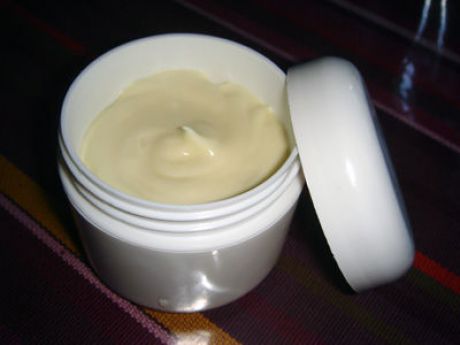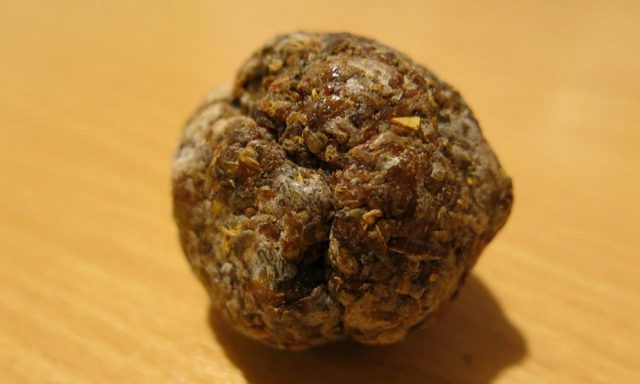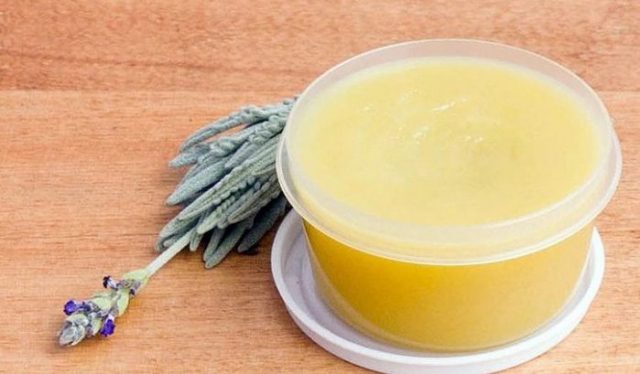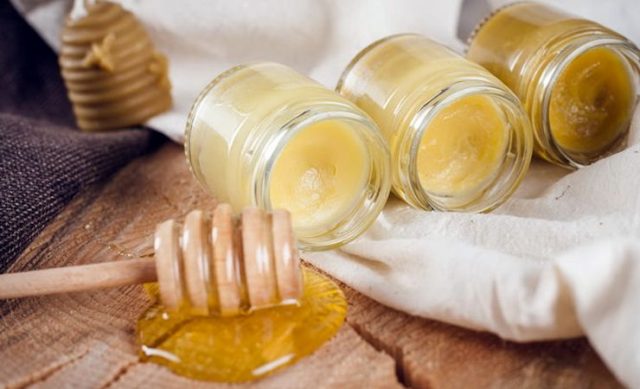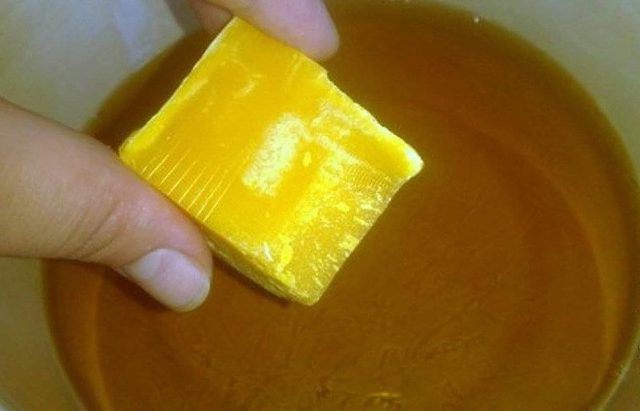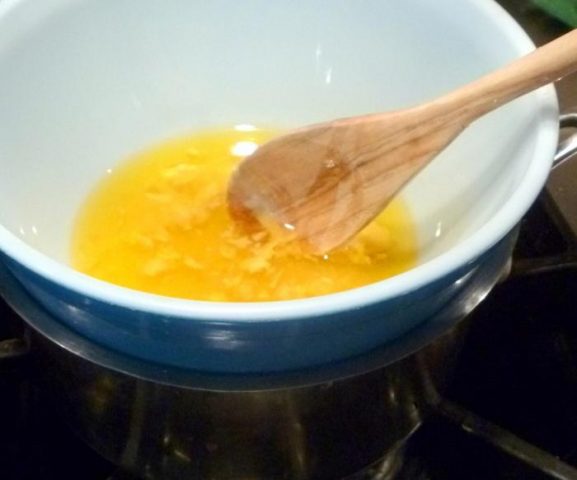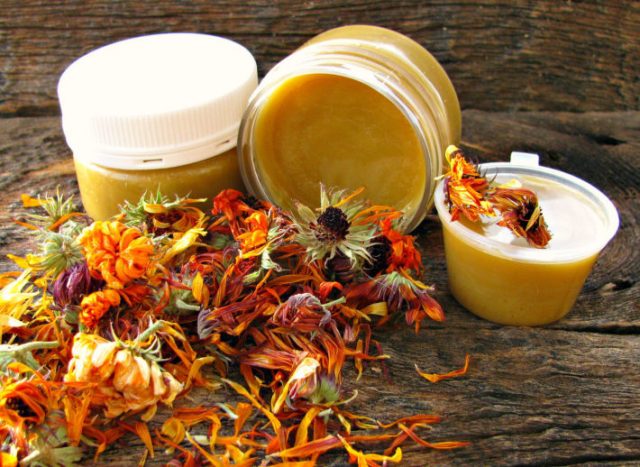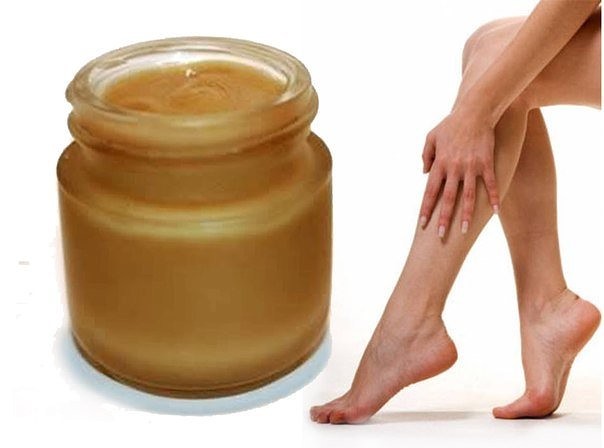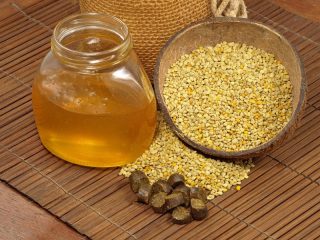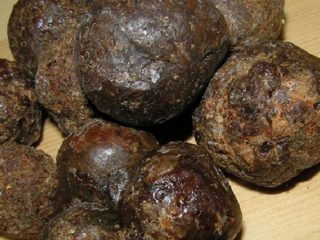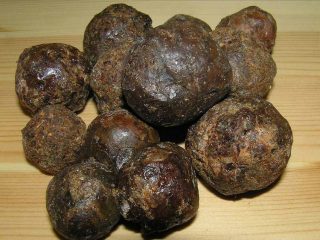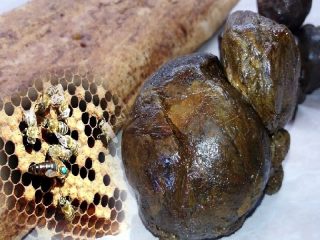Content
- 1 Useful properties of propolis ointment
- 2 What helps
- 3 How to make propolis ointment at home
- 3.1 How to make propolis and petroleum jelly ointment
- 3.2 Propolis and vegetable oil ointment
- 3.3 How to make wax propolis ointment
- 3.4 Propolis ointment at home with butter
- 3.5 Making propolis ointment at home with yolk
- 3.6 Propolis ointment at home with resin
- 3.7 Propolis ointment at home with calendula
- 4 Application rules
- 5 Contraindications
- 6 Terms and conditions of storage
- 7 Conclusion
Propolis ointment is a homeopathic remedy used to accelerate regeneration and relieve pain. You can buy it ready-made at the pharmacy or prepare it yourself. Propolis ointment recipes at home are based on herbal decoctions and vegetable oils, which everyone has access to.
Useful properties of propolis ointment
Propolis is a beekeeping product with a resinous consistency. Its color ranges from white to dark brown. A distinctive feature of propolis is the content of many useful compounds, including:
- mineral salts;
- vitamins H, B6, B2, E, A, C and B1;
- organic acids;
- proteins;
- antibacterial substances;
- trace elements (silicon, iron, sulfur, aluminum, fluorine, phosphorus, potassium).
Due to its beneficial properties, propolis is widely used in pharmacology. It has bactericidal and anti-inflammatory effects. Propolis ointment has positively proven itself in the treatment of colds, skin rashes, hemorrhoids and pathologies of the genitourinary system. Its useful properties include:
- acceleration of the regeneration process;
- neutralization of an unpleasant odor;
- removal of inflammation;
- elimination of discomfort, pain and itching sensations;
- antifungal effects;
- getting rid of bruises;
- activation of metabolism;
- improving the blood circulation process;
- restoration of blood pressure;
- choleretic and diuretic effects.
The main advantage of the propolis medicine is considered to be of natural origin. When applied locally, it does not have a systemic effect on the body, which reduces the likelihood of side effects. But if used improperly, a remedy can be harmful to health. Therefore, before using it, an allergic reaction test is carried out.
What helps
Propolis ointment is widely used in folk medicine. It is an essential natural medicine. Due to the increase in local immunity and effective regenerative properties, the agent is used for skin diseases. Propolis blend eliminates pain and discomfort in a short period of time. The drug is used in the following cases:
- dermatitis;
- open wounds;
- hemorrhoids;
- diseases of the gastrointestinal tract;
- psoriasis;
- trophic ulcers;
- gynecological pathologies (erosion, colpitis, thrush);
- colds.
In each individual case, a certain concentration of the active substance is required. For sciatica and complicated skin diseases, 40% ointment is used. The concentration of 20% is suitable for the treatment of frostbite, fungal diseases and boils. An ointment containing 15% of the active substance is used to combat acne and joint diseases.10% is the best option for eliminating gynecological diseases, cold symptoms, hemorrhoids and cosmetic imperfections.
Propolis blend is particularly effective against arthritis. At the initial stage, the disease is characterized by latent symptoms. In the future, there are painful sensations in the joints and an increase in local temperature, which is caused by the inflammatory process. The medicine acts on the cause of the disease. A significant improvement in well-being is observed after 1-2 weeks of using the medicinal mixture.
How to make propolis ointment at home
A propolis-based homeopathic remedy can be made at home. There are several recipe variations. In addition to the main ingredient, it contains vegetable oils, animal fats and herbal extracts. The most popular are the following types of ointment:
- lanolinic;
- in butter;
- with wax;
- on fish oil;
- with yolk;
- petroleum jelly;
- with herbal extracts.
Propolis is bought at a regular pharmacy. Most often, a concentration of 15% is found on sale. Bee glue comes in the form of small stones, balls or powder. It does not dissolve in ordinary water. Therefore, the recipe necessarily includes fatty oil, acetic acid or petroleum jelly. Propolis, which has a soft consistency, is considered to be of higher quality, since it does not contain foreign impurities.
How to make propolis and petroleum jelly ointment
Preparation of ointment from propolis and petroleum jelly does not require special skills. You only need 2 main ingredients - propolis and petroleum jelly. The recipe is as follows:
- The concentration of the drug is initially determined. For the very minimum, 5 g of propolis is required.
- The propolis is melted in a water bath until a liquid consistency is reached.
- 100 g of petroleum jelly is poured into the molten base.
- The components are thoroughly mixed, after which the finished mixture is removed into a plastic or glass container.
- The ointment is stored in an airtight jar in the refrigerator.
Propolis and vegetable oil ointment
To prepare a homeopathic remedy in vegetable oil, you will need:
- 15 g of bee glue;
- 100 g of vegetable oil (or olive).
To obtain a medicine, you must:
- Melt butter at 80 ° C.
- Add propolis to the fat base.
- Bring the ointment to readiness, stirring occasionally.
- Turn off the stove after the ointment becomes viscous.
- Leave the mixture on the cooling plate for 20 minutes.
- Strain excess moisture through cheesecloth.
- Cool the medicine at room temperature and place in a container with a tight lid.
How to make wax propolis ointment
Do-it-yourself propolis ointment is often made on a wax basis. It helps eliminate cracked heels and relieve joint pain. The recipe includes the following components:
- 1 chicken egg;
- 30 g of beeswax;
- 150 g of propolis.
The drug preparation algorithm is as follows:
- Boil a hard-boiled chicken egg and cool it in cold water.
- Separate the yolk from the protein and grind.
- Place all components in a container and put in a water bath.
- After 20 minutes, the resulting mixture is cooled and filtered.
Propolis ointment at home with butter
An ointment prepared on the basis of butter is used not only transdermally, but also orally. The second option is suitable for the treatment of diseases of the digestive system. According to the recipe, the composition includes:
- 1 pack of butter;
- alcohol tincture of propolis at a concentration of 10%.
Cooking process:
- The ingredients are mixed in a 10: 1 ratio.
- The mixture is heated over low heat until boiling.
- After the product has cooled, it is filtered.
Making propolis ointment at home with yolk
Propolis mixture with the addition of chicken yolk is considered to be an effective cosmetic product. In combination with an egg, propolis has a positive effect on the condition of the hair. To prepare an egg ointment on propolis at home, you will need:
- 1 tsp lemon juice;
- 1 egg yolk;
- 1 tbsp. l. honey;
- propolis oil.
Cooking process:
- The components are mixed until a homogeneous consistency is achieved.
- The healing mixture is heated in a water bath and left to cool.
- After cooling, the remedy can be used.
If the mixture is used to restore hair structure, it is applied after shampooing. The product is distributed over the entire length without affecting the roots. After applying the mask, the head is covered with a plastic cap. After 15-20 minutes, the ointment is washed off with warm water and shampoo.
Propolis ointment at home with resin
Resin is called the resin that is released on the cedar bark. It is appreciated for its antibacterial, wound healing, vaso-strengthening and analgesic effects. To prepare the ointment at home, use:
- 100 g of vegetable oil;
- 10 g resin;
- 20 g of propolis.
Any oil is allowed to be used. The main condition is the absence of extraneous additives in it. The medicine is prepared according to the scheme similar to the recipes described above. Most often, the melted and strained mixture is used to heal skin diseases.
Propolis ointment at home with calendula
Calendula has the ability to soothe irritated skin. As part of home recipes, it is used to relieve inflammation and prevent varicose veins. To make an ointment at home, you need:
- 100 g butter;
- 2 drops of tar;
- 10 g of propolis;
- 1 tbsp. l. crushed calendula flowers.
Cooking algorithm:
- The components are mixed with each other.
- The mixture is heated in a water bath for 10 minutes.
- After complete cooling, the medicinal ointment is filtered.
Application rules
Before using propolis ointment at home, you need to test for an allergic reaction. A small amount of medicated ointment is applied to the inner area of the elbow. After 20-30 minutes, the skin reaction is assessed. The principle of application is determined by the nature of the disease. You need to focus on the following rules:
- For the treatment of skin diseases and cosmetic imperfections, the ointment is applied directly to the damaged area. A bandage is made if necessary. It is important that the remedy is fixed on the surface of the skin for 3-4 hours.
- Gynecological diseases are treated by inserting tampons soaked in a medicinal agent into the vagina. The duration of therapy is 2 weeks.
- Inside, it is permissible to take an ointment containing edible oils (olive, vegetable, butter).
- In case of burns and bruises, the ointment is rubbed into the damaged area with a thin layer, massaging movements. The duration of treatment is determined by the therapeutic result.
- Furunculosis is treated by applying a gauze pad with propolis ointment. Treatment is carried out until the purulent contents come out.
- For colds, the ointment is diluted in water and used to rinse the mouth. Nasal congestion is fought by rubbing the bridge of the nose with a drug.
- For hemorrhoids, it is recommended to apply a 10% ointment. Before applying, it is advisable to empty the intestines and carry out hygienic procedures. The ointment is spread over a small piece of cotton wool or sterile bandage. Such a compress is applied to the hemorrhoid.
Contraindications
In some cases, the use of propolis ointment is strictly prohibited.Special care should be taken for pregnant women and children. During the period of childbearing, the possibility of using the ointment on an individual basis is specified by the gynecologist. Contraindications to the medicinal mixture include:
- malignant formations;
- allergy to bee products;
- eczema;
- bronchial asthma;
- period of exacerbation of liver disease.
Terms and conditions of storage
At home, it is customary to store the propolis mixture in a glass or plastic container with a tightly closed lid. The sun's rays should not fall on the drug. It is advisable to remove the drug in a dark place with a cool temperature. The total shelf life is 2 years. But under unfavorable conditions, the product may deteriorate earlier. It is recommended to make a small amount of the ointment.
Conclusion
Propolis ointment recipes at home are selected based on the specifics of the disease. A properly prepared medicinal mixture helps to improve well-being without harmful effects on the body. Therefore, it is important to respect the proportions of ingredients and storage conditions.

